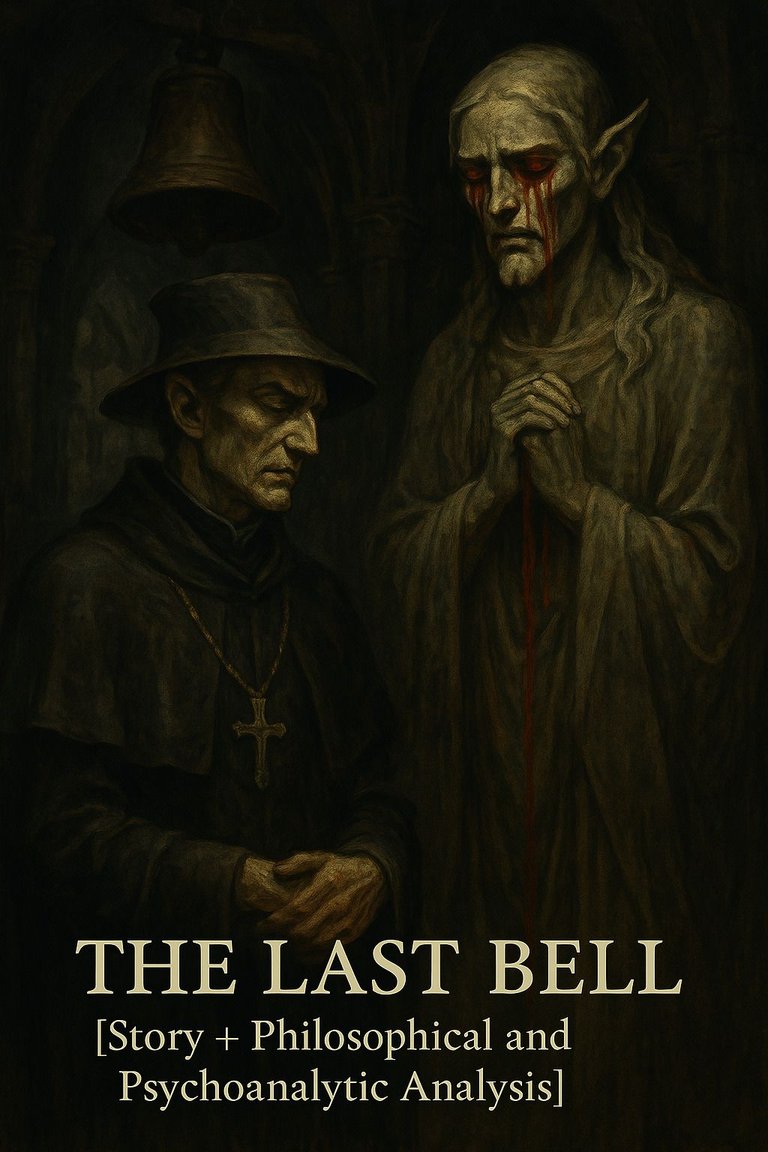In the depths of an abandoned monastery at the heart of Noctira, a vampire priest named Andreius lived alone. Once, within the stone walls of this sacred place, he had sworn to honor the gods of his kind. But now, in the solitude of the night, he struggled with memories of a past long buried. The bells, which had been silent for centuries, now rang out each night. The sound came from the depths of the earth, resonating throughout Noctira.
At first, Andreius thought the bells were simply reminders of a bygone era of repentance. But there was something unsettling about the way they sounded. These bells were not signs of forgiveness; they were cries of guilt. Guilt that flowed through the veins of every vampire in the land. Following the advice of the oldest monks of the monastery, Andreius ventured to the ancient statue that stood in the heart of the sacred place.
This statue depicted a long-forgotten vampire god, once worshipped as a divine being. But now something was different. Blood tears flowed from the stone eyes of the statue. Andreius stood before it, unable to look away. The blood was not just a symbol of divine power, but a revelation of a hidden truth. It was the blood of those who had been sacrificed in the past—those who had prayed to escape the eternal curse of vampirism, but had never been forgiven.
Andreius found himself staring into the statue’s eyes. The blood tears were more than a mere symbol; they revealed a painful truth: Are we, vampires, truly gods, or merely the condemned, paying for sins we have long forgotten? Each night, the bell would ring again, and Andreius resisted the revelation. He couldn’t bring himself to accept what the tears revealed.
He knew he couldn’t speak the truth—not because of the consequences, but because the truth would shatter everything he had believed. In the nights that followed, he stood at war within himself. The choice between accepting the truth or denying it seemed insurmountable. But as the blood tears continued to flow, Andreius remained silent. What remains for a vampire when he can no longer escape the lie that has defined his existence?
Philosophical and Psychoanalytic Analysis
The Concept of Original Sin and the Repetition of History
In this story, Andreius represents a philosophy where sin is not just an individual trait but a collective and historical burden. Sin, in this context, is not something that can be escaped or atoned for by any one vampire; it is ingrained in the very fabric of vampiric existence. The idea that sin is an eternal inheritance, passed down through generations, reflects the notion of original sin in religious and philosophical discourse. For Andreius, confronting this truth forces him to question whether vampires are truly divine or merely the condemned who inherit the weight of an ancient wrong. This sin, much like history itself, cannot be escaped.The Concept of Truth and Illusion in Psychoanalysis
The blood tears from the statue serve as a psychoanalytic symbol of "collective trauma"—the idea that traumatic experiences do not just affect individuals, but entire cultures or species. In psychoanalytic terms, collective trauma refers to painful events that are suppressed in the collective unconscious and re-emerge at critical moments. For Andreius, the blood tears are more than just a religious symbol; they represent a painful reawakening of a past that cannot be denied. His struggle is between seeing the truth and remaining in the comfort of the illusion that his faith has been built upon.A Critique of Power and Faith: Truth and Belief in the World of Vampires
Andreius faces a critical philosophical dilemma: if all systems of power and belief are built upon a lie or a sin, can they still be worth upholding? This situation poses the question: If the foundation of our faith is a lie, can we continue to hold it, or must we abandon it? Andreius’s internal battle is a reflection of the struggle between faith and knowledge, between the comfort of blind belief and the chaos that comes with accepting the truth. His refusal to accept the reality of the blood tears shows his unwillingness to face the collapse of the system that has given him purpose and identity.Psychoanalysis and Denial: Defending Identity Against Existential Crisis
In the end, Andreius chooses to deny the truth. This is not simply a fear of the consequences, but a defense mechanism called "denial"—a psychological process in which an individual refuses to accept an uncomfortable truth. As Andreius stares into the blood tears, he is unable to reconcile the truth with his identity. The denial allows him to preserve his sense of self and avoid the existential crisis that would arise from the collapse of his beliefs. This defense mechanism speaks to a deeper psychological need to preserve one's identity at all costs, even if that means ignoring a painful truth.
In essence, this story illustrates the profound philosophical and psychoanalytic struggles that emerge when an individual's world is shattered by the revelation of an uncomfortable truth. Andreius’s denial is a reflection of the broader human (or vampiric) condition: the struggle to maintain a sense of self in the face of existential dread.

Congratulations @sadaf.alinia! You have completed the following achievement on the Hive blockchain And have been rewarded with New badge(s)
Your next target is to reach 300 posts.
You can view your badges on your board and compare yourself to others in the Ranking
If you no longer want to receive notifications, reply to this comment with the word
STOPCheck out our last posts: